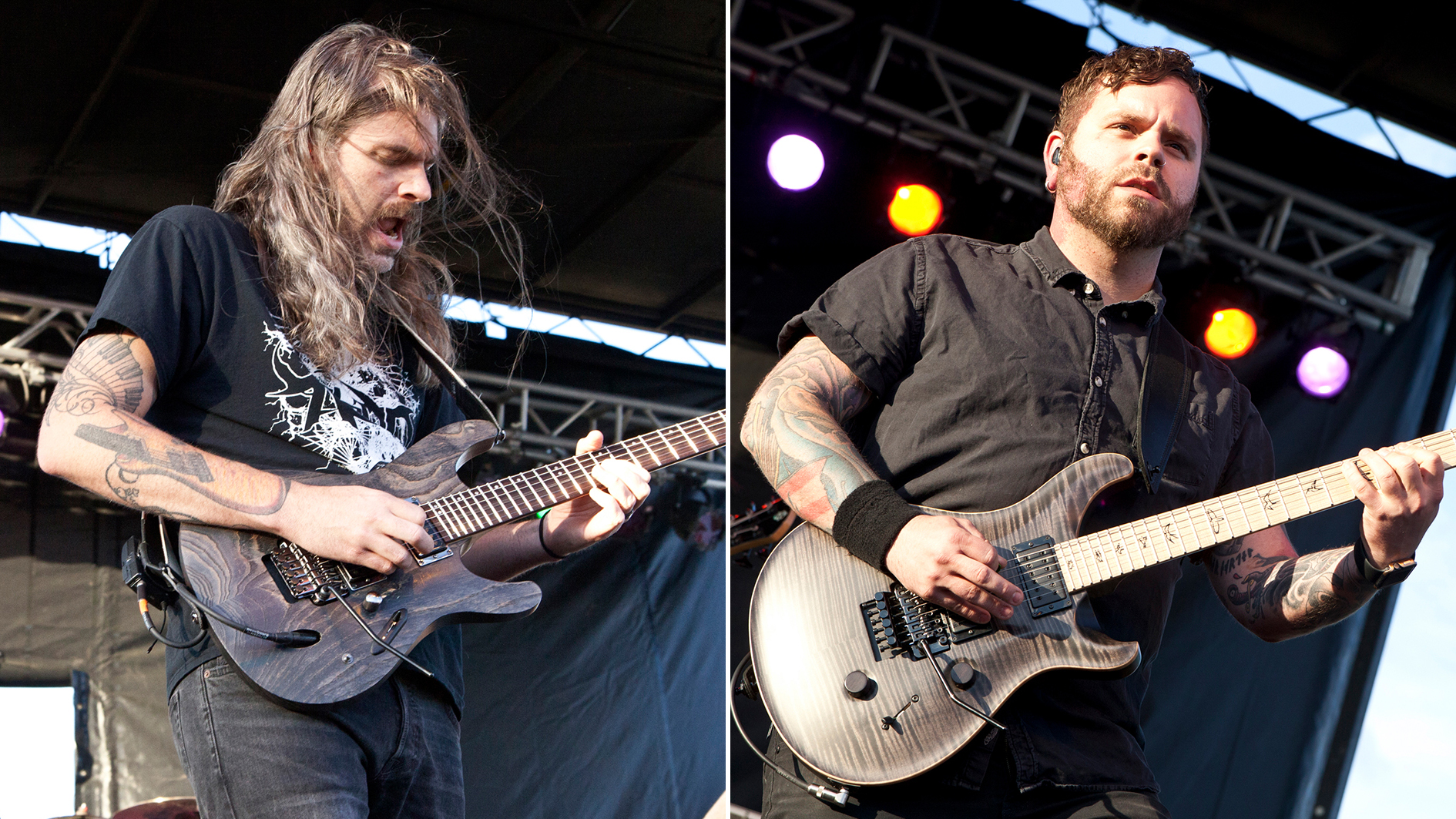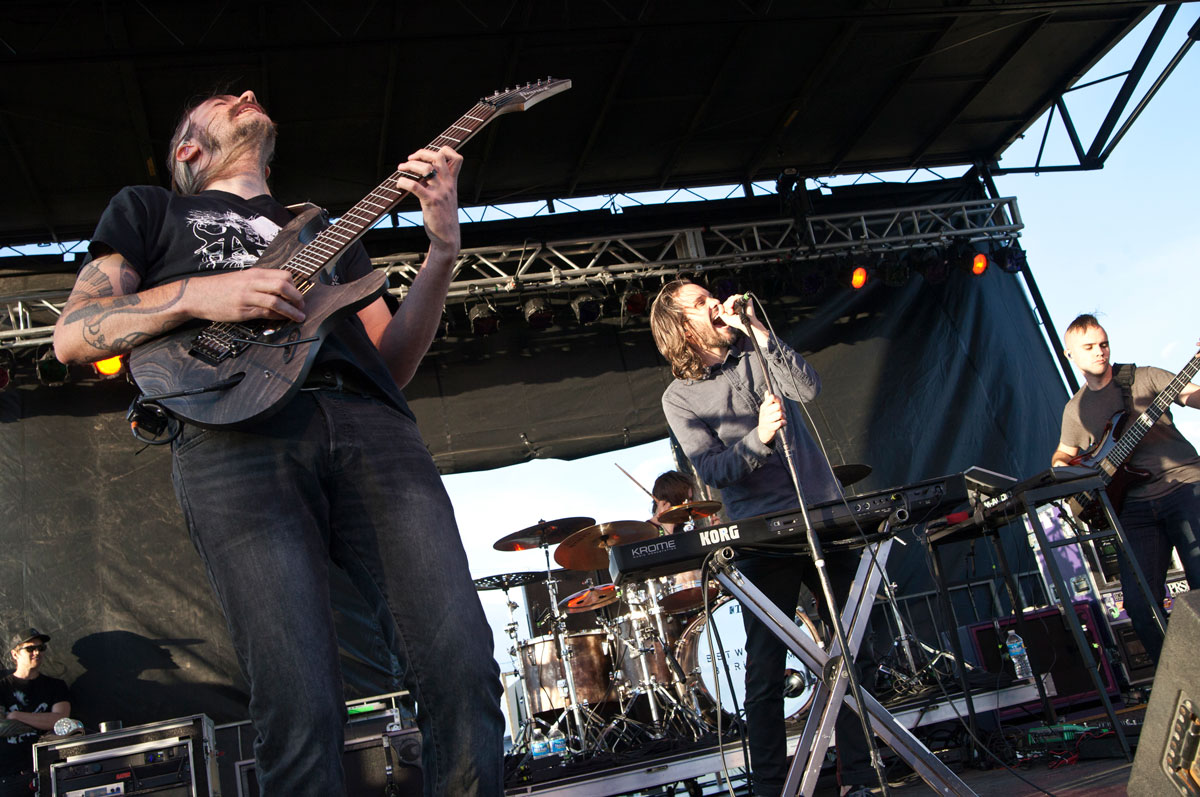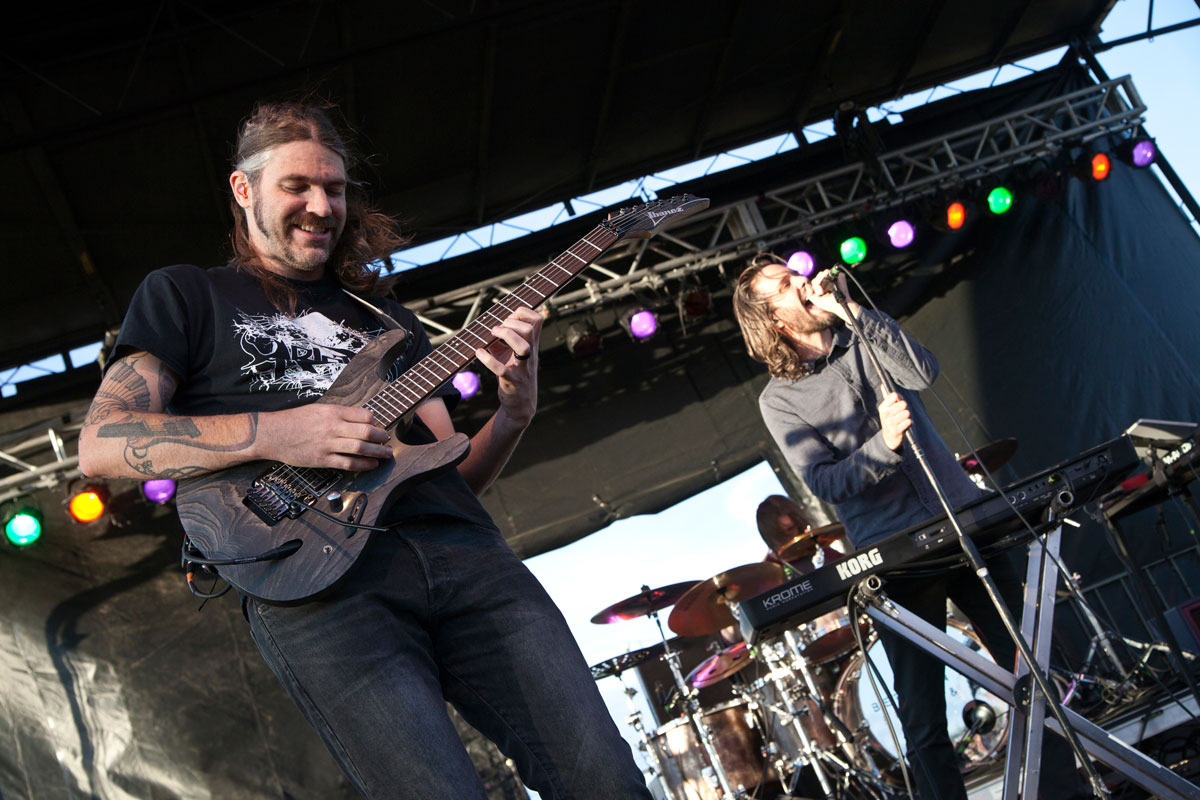Between the Buried and Me: "We took everything we do, and we notched it up a bit. It’s everything that everyone either loves or hates about BTBAM!"
Guitarists Paul Waggoner and Dustie Waring talk philosophically doubling down on 2007's Colors with epic, hugely diverse new full-length Colors II

When Guitar World reaches Between the Buried and Me’s Paul Waggoner and Dustie Waring, the guitarists are taking a quick break from last-minute tour rehearsals in North Carolina.
Outside of a livestream concert on Twitch last February, this summer finds the Raleigh-formed progressive metalheads performing live for the first time since before the pandemic.
Lockdown proved to be especially prolific times for the adventurous metal hybridists, though, as they’re also due to deliver their upcoming album Colors II on August 20.
As fans can guess by its title, the band’s 10th album is the sequel to 2007’s Colors. Waggoner explains that it’s a spiritual successor that had the quintet re-evaluating their legacy, while likewise looking to push the hybridists’ already infinite limits.
The scope is fittingly epic. At times, Waggoner and Waring rip into their fretboards with harmonized, tech-heavy crawls (Monochrome, The Double Helix of Extinction), while elsewhere they cross-pollinate prog with hip-swerving bossa nova (Revolution in Limbo).
The band also gleefully graft together ragtime piano, backwards-masked blast beats and Looney Tunes sound effects (Pre-History), and conjure an unholy, but fun-as-hell union of gospel and thrash (Fix the Error).
But while Colors II is a high-watermark for the veteran Between the Buried and Me, you’re going to have to wait another tour cycle before getting hit with the Pollock splatter of Colors II in-person.
Get The Pick Newsletter
All the latest guitar news, interviews, lessons, reviews, deals and more, direct to your inbox!
“We were supposed to have done this tour before we even wrote Colors II,” Waggoner explains. “The tour was meant to be a retrospective of entire catalogue, as well as a celebration of what would have been the 10 year anniversary of [2009’s] The Great Misdirect. We wanted to keep that vision intact. So we’re not really focusing on any of the Colors II material.”
Even so, Waggoner and Waring were happy to dish on the well-worn guitars, audio Easter eggs, and vibrant tone palette of their Colors II.
A few times, now, Between the Buried and Me have gone for these multi-part releases – from the combined Parallax EP and LP, to Automata I and II, and now with Colors II. What is it that attracts you to this idea of an explicitly linked musical continuum?
Paul Waggoner: “It’s a fun challenge to try to build on something. In the case of Parallax, that was one story. Lyrically, it was conceptual – [the EP] was written as the exposition of the story, and then the guts were in Parallax II.
“Automata was written as one album, but we decided to release it in two parts as an experiment in – I don’t know – marketing? [laughs] We wanted to see if people were able to digest it in smaller components.
“Colors isn’t a lyrical concept, its more musical – or more of a philosophical continuation. It was more about the mindset we were in when we wrote the record.
“We felt similar to how we felt back in 2007, when we wrote Colors I. It was us in 2020 feeling very much like we did in 2007, feeling like we had to go next-level with this album. We had to write something that was going to solidify our identity, and that’s how we felt when we wrote Colors I.
“So there are some callbacks, little musical nuggets here and there where we reference parts from Colors I. But for the most part it’s just a new Between the Buried and Me album.”
As we often do in BTBAM, parts start to take on a whole other life once we start recording
Paul Waggoner
What put you back into the headspace of wanting to level up?
Waggoner: “I don’t think we’re the only band that feels this way – especially bands that have been fortunate enough to have careers as long as ours – but you have these moments where you feel like your backs are against the wall.
“You feel the internal pressure to do something really special. It’s just a gut feeling – you feel like the next one’s gotta be badass, you know? I think a lot of bands have those moments where they feel like, ‘fuck man, if we don’t knock it out of the park with this next one, the rug could get pulled out from under us. We gotta make sure we do something special and push ourselves to new limits.’”
How quickly did it take to lock into those badass ideas?
Dustie Waring: “This album was written over the internet, completely, due to the pandemic. As soon as we started sending parts to each other, we noticed that it was something to be excited for. We were all like, ‘Damn guys, we’re really enjoying what everyone’s coming up with.’ It’s a much heavier record than our last few, so we were just excited straight away.”
It sounds like you had a ton of fun making Fix the Error – this boisterous genre flip with gospel organs, and a bit of country-thrash fusion to it. Where did that come from?
Waggoner: “Blake [Richardson, drums] came up with the whole first half of the song, with the gospel organs. It’s obviously very drum-forward – [especially with] the drum solo section.
“After that he was like, ‘Hey, maybe after that we can go into this melodic power metal section,’ which I guess is where I came in. That took shape quickly as a fun, quirky, and pretty concise BTBAM song. I don’t think that song is really the embodiment of what the album is about, as a whole, but it is a fun departure from what we normally do.
“As we often do in BTBAM, parts start to take on a whole other life once we start recording. When we record a metal part and start throwing banjos and mandolins into the mix, it becomes this whole other thing – as you said, thrash-bluegrass fusion.”

Since you brought it up, there are banjos on Fix the Error, mandolins on Pre-History. Who took on those parts?
Waggoner: “Either me, Dan [Briggs, bass], or Dustie. We actually don’t use a traditional banjo or mandolin [tuning], because of our tuning [traditionally C#] it would be pretty hard to do. So we use a banjitar... it’s really just like playing guitar. I think Dan probably played the mandolin on Pre-History, and I think I did it on Fix the Error.
“It’s not a very professional process when we record. Whoever happens to be there, its like, ‘Hey, get in the frickin’ booth and track this banjitar real quick.’ It’s basically all hands on deck – whoever’s around will go in there and mess around with it to see what happens.”
Paul, Ibanez introduced the PWM20 this year, the successor to your previous signature. Was that put to use in the sessions? Did you have a prototype to work with?
Waggoner: “I used it, though I would say most of the heavy stuff I did with the older model, the PWM10. You know how it is – sometimes the older, beat-up, raggedy-ass guitar sounds the best in a studio setting.”
Waring: “I think you used the newer one for most of the leads, though.”
Waggoner: “I probably did.”
Waring: “It had a brighter sound.”
What kind of spec upgrades went into the PWM20?
Waggoner: “They’re almost the same, in terms of specs; they‘re both swamp ash bodies [but] no piece of wood is the same. Like Dustie said, the newer one just had a spankier, clearer tone, which is good for leads, but for the rhythm tone we were going for it was a little too bright. Again, if I took that same guitar in there now, it would sound totally different.”
Waring: “We both bring two to four of the same guitar out on tour, and we have a ton of different guitars in the studios. They can all technically be the same guitar [model] with the same pickups – even the same colour – but they have different tonal characteristics.”
Were you relying on your PRS signature through the sessions, Dustie?
Waring: “I was using my model, the PRS DW CE 24 Floyd. My trusty blacktop is my go-to guitar, [but] I brought a lot of guitars. We just went by what the part was calling for, tonally.
We experimented a lot on this album, a lot of different tones and a lot of different guitars. There’s acoustic layering, mandolin, banjo, upright bass – all kinds of things going on
Dustie Waring
“I had two of my signatures; I had a PRS Jazz Box hollowbody; we had a custom shop Tele; we had a PRS Superstrat – kind of hum-single-single guitar; and a few of Paul’s Ibanez's.
“No matter who is recording the part, my side [left speaker channel] is my guitar; Paul’s side [right speaker channel] is Paul’s guitar. Some people may think that’s pointless, but it’s more authentic to what you’re going to hear live, because our guitars and pickups do sound different – customized to what we personally like. We’ve done that for several records now.
“We experimented a lot on this album, a lot of different tones and a lot of different guitars. There’s acoustic layering, mandolin, banjo, upright bass – all kinds of things going on.”
Revolution in Limbo runs through some viciously metallic mosh and shred moments, but are there some detuned steel-string acoustics running through that mellow, Latin music-styled mid-section?
Waring: “We used my JA-15 hollow body for the rhythms in the bossa nova section. That guitar sounds almost like a nylon string when you’re playing through something really clean. I know that we used that for the rhythms.
Waggoner: “I think I used the PW for the leads, but we used all kinds of stuff. There’s also a detuned nylon-string in there – just an old-ass nylon-string guitar that I got when I was 16 years old. It probably has the same strings on it, too.”
One of the thickest grooves on the record is on Bad Habits, this swampy rock riff with a wah-wah slathered lead...
Waggoner: “Well, Dustie plays a maniacal solo in that section right before it, which I feel sorry for him for having to try and duplicate that live.”
Waring: “It’s going to be a hell of a time.”
Waggoner: “The riff you’re talking about, though, is a pretty direct callback to a riff in Ants of the Sky from Colors I. Dan wrote the original and the modified Colors II version on Bad Habits. Kind of a classic rock riff. Of course, we were like, ‘We’ve got to put a wah pedal on this thing!’”
Waring: “Anytime we do parts like that I’m like, ‘All right, we’ve got to pretend we’re in Kansas for a second.’”
Waggoner: “The band, he’s talking about!”

What are some of the other callbacks on the record?
Waring: “Well, in the last track [Human is Hell (Another One With Love)] for just a second there is a riff from Prequel to the Sequel, right Paul? I’d say theme-wise, there’s a tip of the hat to Colors I in a lot of ways.”
Waggoner: “A lot of them are really nuanced, just little pieces of ear candy where I think diehards fans will be like, ‘Wait a minute, that sounds like...’”
There are some epically paced songs on the album – you cap the record with the 15-minute Human is Hell, for instance. Sfumato, by contrast, is the record’s shortest moment, at just over a minute long, but it leaves an impact – super-spacious with the delays; the slightest of trem dipping. What can you say about the spritely, if distant lead work on the piece?
Waring: “I just tried to think, ‘What would Tom Selleck be listening to while driving around in an ’85 Camaro by a beach somewhere?’”
Texturally, what were you working with?
Waring: “I just had my guitar hooked up to a super-wet lead sound. Something that [Journey’s] Neal Schon would play through, with tons of reverb and delay.
“That part was all about vibe. A lot of my favorite guitar players are vocal players – they’re not necessarily blasting your head off with shred. They’re just doing stuff that you could sing, you know? I was going for an epic, melodic, sing-y part.
Waggoner: “That’s kind of a weird section. The rhythmic pattern is in 9/4, so it’s an oddly metered section. Dustie’s phrasing meanders in a really cool way – a lot of the phrasing is in four, though the actual part is in nine. As a listener, I like parts where I don’t know where the one is. That’s what gives it such a cool vibe.”
Earlier you’d hinted that Fix the Error isn’t necessarily the thesis statement of Colors II, so what’s the overall MO of the record?
Waring: “I’m very happy with the album. I think this is some of our best work, ever. It’s weird, though – picking a single was damn-near impossible. It’s impossible to pick one song that represents the album... [because] I love everything about the album. There’s not one little morsel of it I’m unsure of; I think we’re all on the same page.”
Waggoner: “To piggyback on that, I just think it’s a really balanced album for BTBAM. It perfectly encapsulates where we’re at as people and as musicians, and as a band. The heavy parts are super-duper heavy; the proggy parts are super-proggy; the quirky stuff is super-fun. We took everything that BTBAM does, and we just notched it up a bit. It’s everything that everyone either loves or hates about BTBAM. It’s all in there.”
- Between the Buried and Me's new album Colors II arrives August 20 via Sumerian.
Gregory Adams is a Vancouver-based arts reporter. From metal legends to emerging pop icons to the best of the basement circuit, he’s interviewed musicians across countless genres for nearly two decades, most recently with Guitar World, Bass Player, Revolver, and more – as well as through his independent newsletter, Gut Feeling. This all still blows his mind. He’s a guitar player, generally bouncing hardcore riffs off his ’52 Tele reissue and a dinged-up SG.
“The rest of the world didn't know that the world's greatest guitarist was playing a weekend gig at this place in Chelmsford”: The Aristocrats' Bryan Beller recalls the moment he met Guthrie Govan and formed a new kind of supergroup
Carlos Santana hospitalized following pre-show medical emergency



![[from left] George Harrison with his Gretsch Country Gentleman, Norman Harris of Norman's Rare Guitars holds a gold-top Les Paul, John Fogerty with his legendary 1969 Rickenbacker](https://cdn.mos.cms.futurecdn.net/TuH3nuhn9etqjdn5sy4ntW.jpg)







